It’s the second day of the annual dinosaur dig hosted by Eromanga Natural History Museum (ENHM) and expectations are high. At a dig site at Plevna Downs, a 1210sq.km working sheep and cattle property about 90km south-west of the outback Queensland town of Eromanga, six people are kneeling in the dirt, deftly and patiently wielding trowels, dustpans and brushes to painstakingly clear away the sandy soil grain by grain. Sitting loosely between them on the surface are three tailbones of a sauropod, a herbivorous dinosaur that roamed here during the late Cretaceous, some 95 million years ago (mya).
Australia is entering a golden age of dinosaur discovery, following a new appreciation of the continent’s unique geology and how that affects the way we’ve been looking for ancient fossils across the continent. In North America and China – traditionally regarded as the world’s major “dinosaur hotspots” – fossils are usually exposed in the eroding rocks of mountains, hills, valleys and canyons. But that’s not the case in Australia, the world’s flattest continent. Here, the landscape is highly eroded, and because it has been subjected to millions of years of weathering, it was once widely assumed that most of Australia’s dinosaur fossils had eroded over time. But a number of sites across the continent are proving this wrong, and Plevna Downs is one of them.
During the past 20 years the partial skeletons of 11 suspected individual sauropods have been recovered from this one working property, owned by Robyn and Stuart Mackenzie. Robyn, the director of ENHM, began studying palaeontology – the science of fossils – after the property began to reveal its prehistoric riches. She’s now one of Australia’s leading field palaeontologists and is heading the dig this week at Plevna. “Dinosaurs capture the attention and imagination and passion of so many people,” she says. “But it’s the work of many. One person can’t dig up Queensland’s dinosaurs on their own, you know. It takes a lot of helpers.”

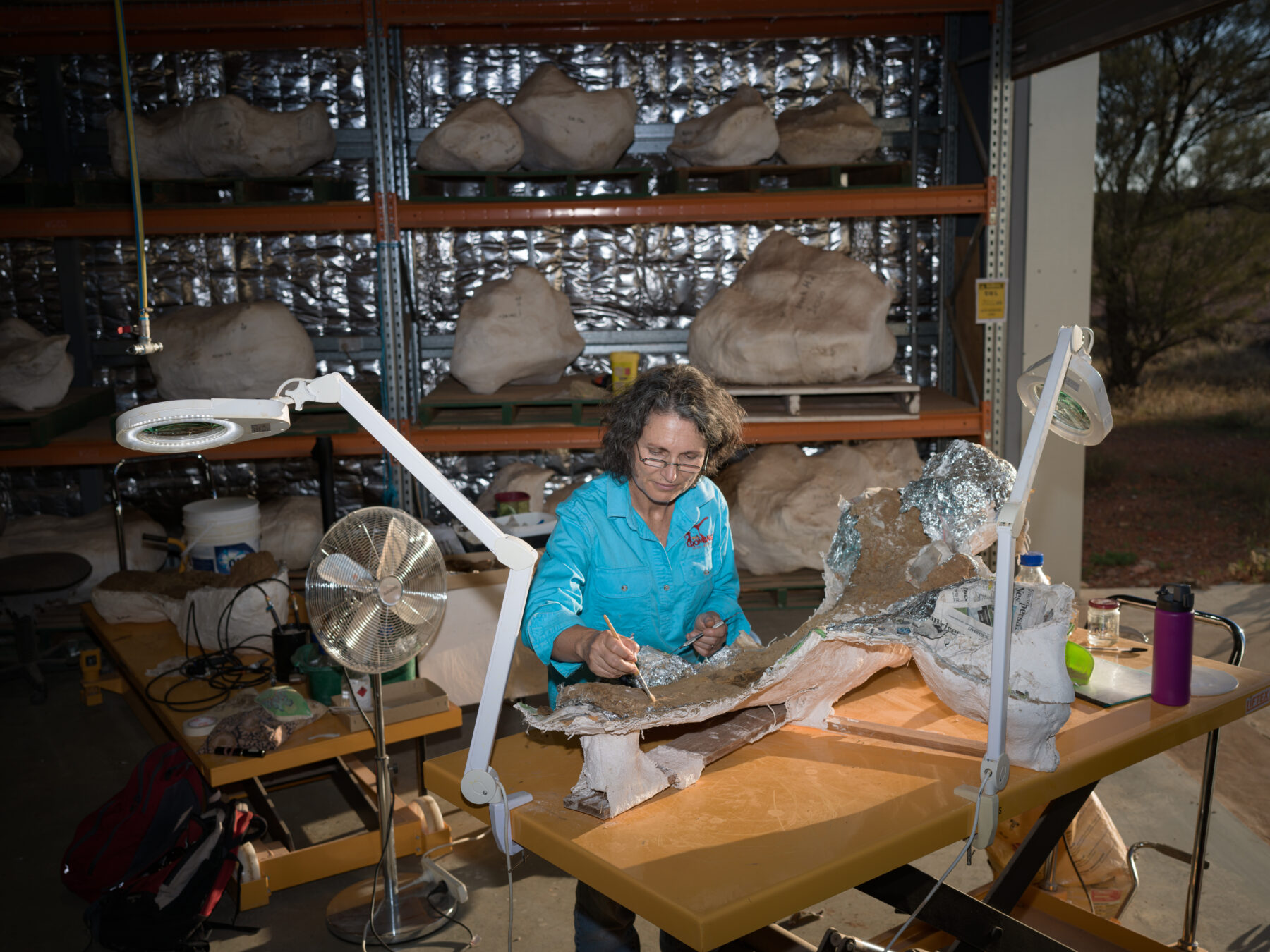
Robyn has been joined for this dig by geologist Melville Wilkinson and four participants who’ve paid for the privilege of working the site. ENHM is one of a handful of museums across Australia that offer paid participants the opportunity to join a multi-day fossil dig and work side by side with leaders in the field. It’s a win-win situation that supports regional museums – preventing material from being carted off to capital cities – and helps fund more digs, while allowing amateur enthusiasts the opportunity “to travel with purpose” and contribute meaningfully to science.

For many, it’s a chance to live out a childhood dream of being a palaeontologist. Tony Purcell from Victoria has encyclopaedic knowledge about dinosaurs. He studied geology at university but was discouraged from pursuing a career in palaeontology after being repeatedly told “there are no jobs” in the field. He’s since volunteered at fossil digs across the globe, including in Morocco, the USA, Canada, the UK and China, and is the only volunteer to own a palaeontology field kit, a small collection of probes and chisels that he keeps tucked into his breast pocket. At this stage of the dig there’s not much to be found apart from scraps of broken bones, but Tony isn’t disappointed. “Finding a bone is great,” he says, “but just fragments mean something.”
Digging next to Tony is Paul Coddington, a return volunteer who joined ENHM’s dinosaur dig in 2019. Paul says these digs are an opportunity to escape his IT desk job in Adelaide for a week and do something completely different. But there’s an element of nostalgia, too. Paul says he grew up reading about T. rex in the USA and ammonites in the UK, but the books never mentioned the fossils found here in Australia.
Until the 1980s, only a handful of dinosaurs had been found in Australia. But the past few decades have seen dinosaur discoveries slowly but surely gain momentum. “There’s a real sense that we’re at the start of a new Australian era in palaeontology,” Paul says.
What’s been excavated so far in Queensland is probably just the tip of the iceberg. Robyn’s property is littered with dinosaur bones. She discovered today’s dig site, currently measuring 25m x 10m, by chance during a water run with her husband, Stuart. “I was driving past and spotted this [the three dinosaur bones] out of the corner of my eye,” she said. “We’d already gone past it. But I’ve got this thing with myself where, if in doubt, you’ve always got to double-check. Even if you feel it’s too much trouble.” Now the dig is underway, there’s a collective feeling of anticipation at what might be found. Robyn and her team will likely spend the next handful of years excavating this site, returning each winter for a two-week digging stint. If it turns out to be chock-full of dinosaur bones, the site could be opened up to 200m in size.
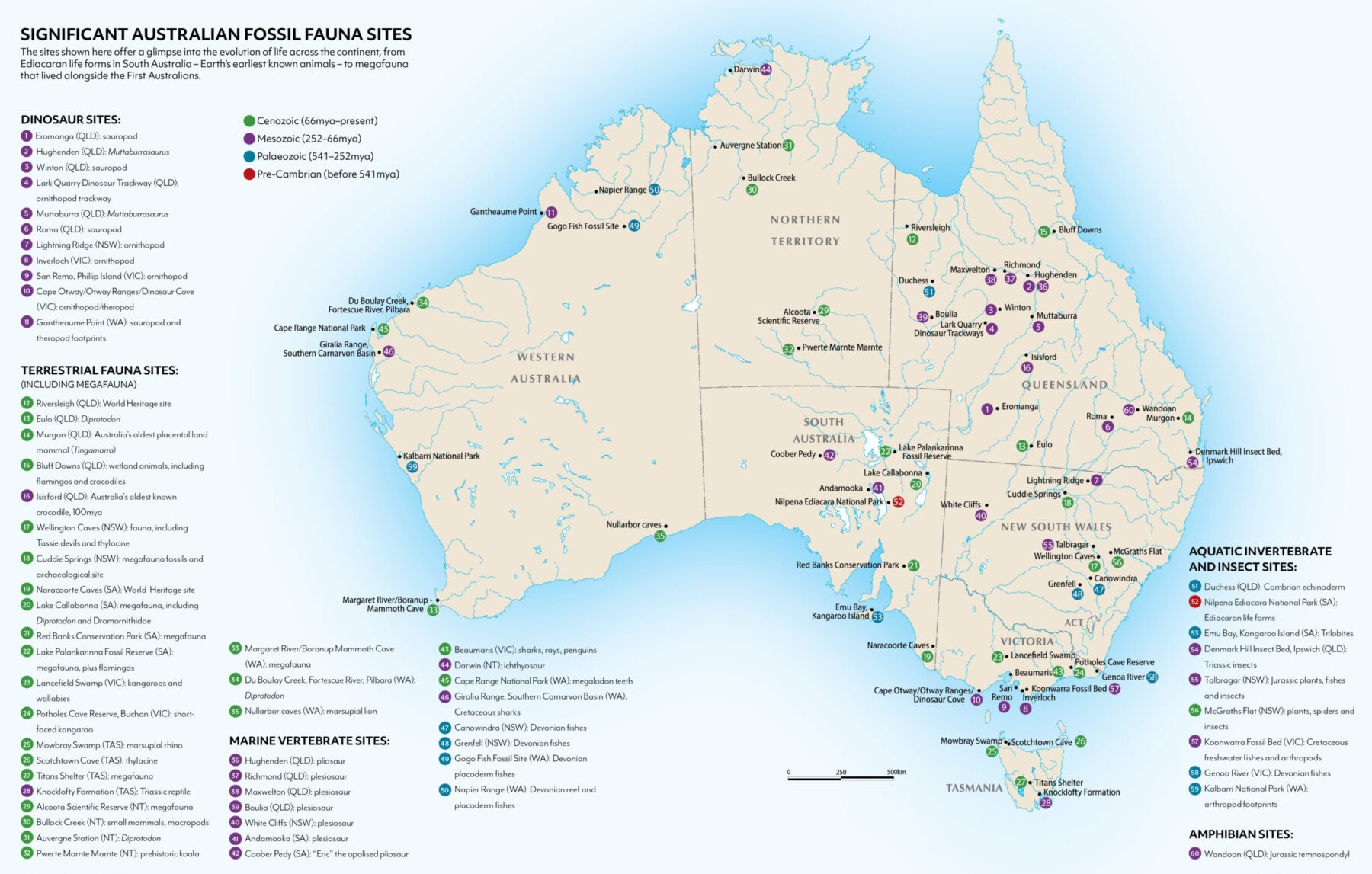
Australia’s largest dinosaur
Robyn admits she had no real interest in palaeontology until her 14-year-old son, Sandy, found an unusual-looking rock on their property in 2004. When researchers at the Queensland Museum confirmed it was a dinosaur bone, Robyn began scouring her property for more. The serendipitous discovery was perfect timing for her; her youngest child had begun boarding school, leaving her with more time on her hands. “I had just finished teaching the children and I was a free agent for a bit,” she says. “I’d get in our four-wheel-drive and go out traversing the landscape. I found four [dinosaur] sites about 50km north of here, on the other end of our property. I was like, this is addictive.”
From 2006 to 2009 Robyn led Plevna Downs’s first excavation at a site near Cooper Creek, about 7km south-west of today’s dig. It uncovered a partial sauropod skeleton – nicknamed “Cooper” – that was formally described in 2021 as Australotitan cooperensis, a genus and species new to science. Zircon dating of uranium–lead isotopes suggests Cooper died about 95mya.
Weighing an estimated 70 tonnes and standing about 6.5m tall and with a length of 30m, Cooper is the largest dinosaur ever discovered in Australia – and the third largest in the world. It took nearly a decade to prepare Cooper’s fossils and remove the mudstone and gypsum crystal from the bones.
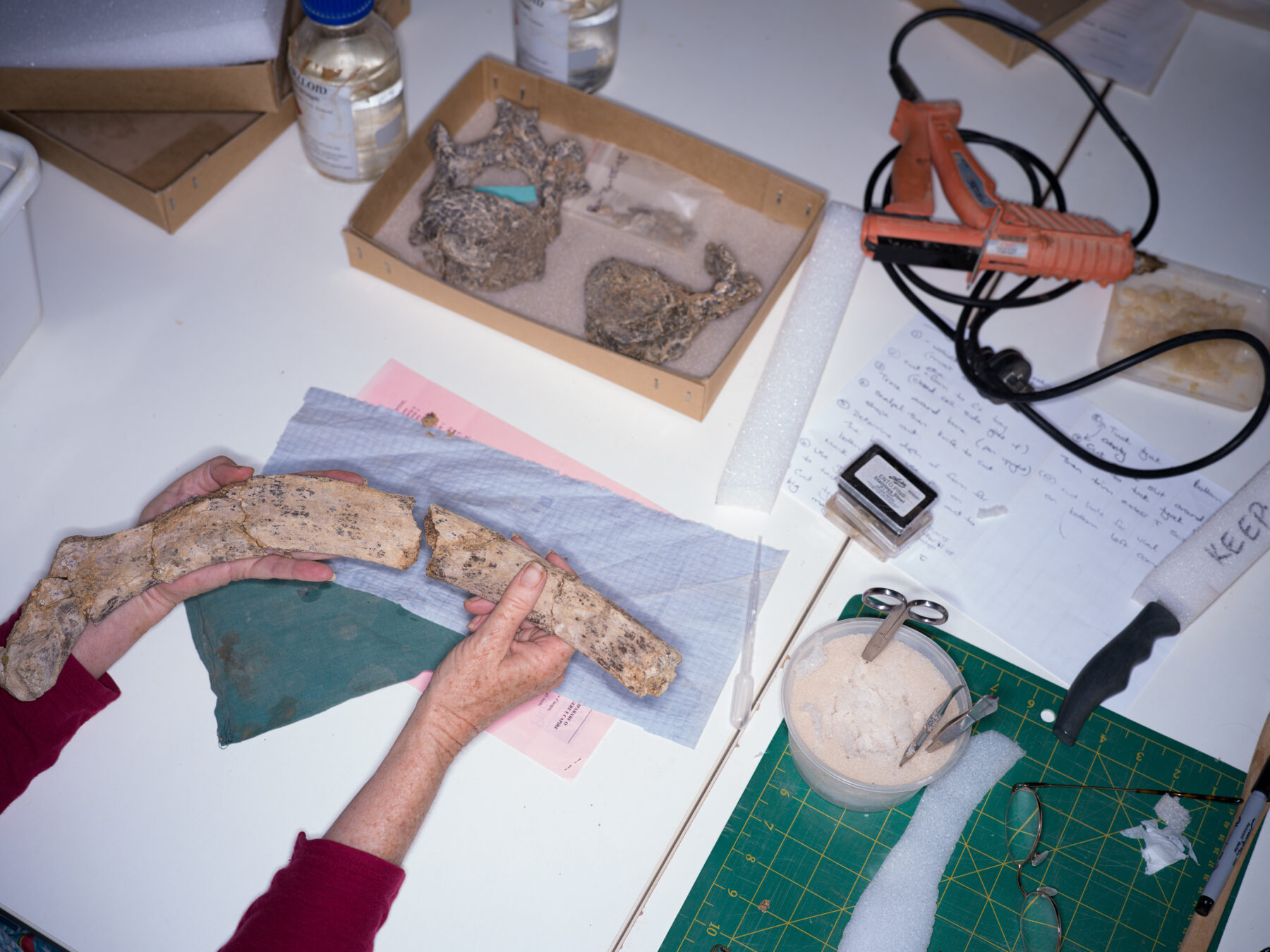
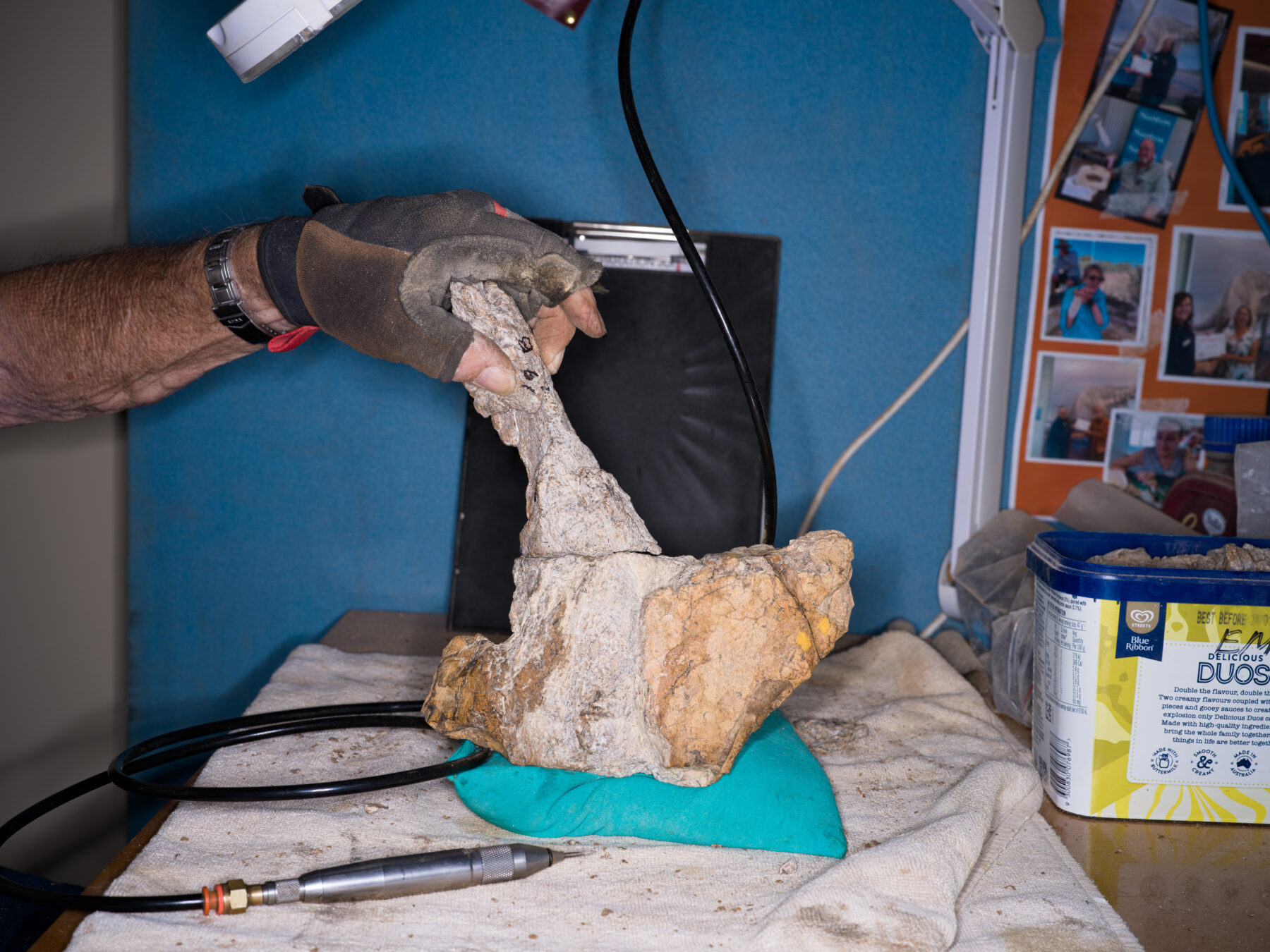
It was during this time that the idea of a regional-based natural history museum emerged, to ensure the material was kept in its own context. ENHM opened in 2016 and now receives up to 15,000 visitors each year.
It’s incredible that 95-million-year-old dinosaur bones are found sitting loosely on the soil’s surface. These dinosaurs were once buried in the bottom 200–300m of the Winton Formation – a layer of sedimentary rocks in central-western Queensland laid down in the mid-Cretaceous period – and covered by 700–800m of soil that has since eroded.
Geologist Wilkinson explains Plevna Downs’s fossils lie on an 80km-long anticline (a geological fold shaped into an arch by immense pressure), which pushes them up towards the surface. From here, the fossils are picked up by black soil; as the ground wets and dries, the soil contracts and gradually pushes the fossils above the ground. “Thirty years ago, if you found bones on the surface, you would assume that it’s just been washed around and that was all that was left. You wouldn’t go and excavate a metre down, but now that’s what everyone does,” Melville explains. “The techniques have changed, and that’s why you’re getting a lot more discoveries in Australia, whereas before there were only a few isolated ones.”

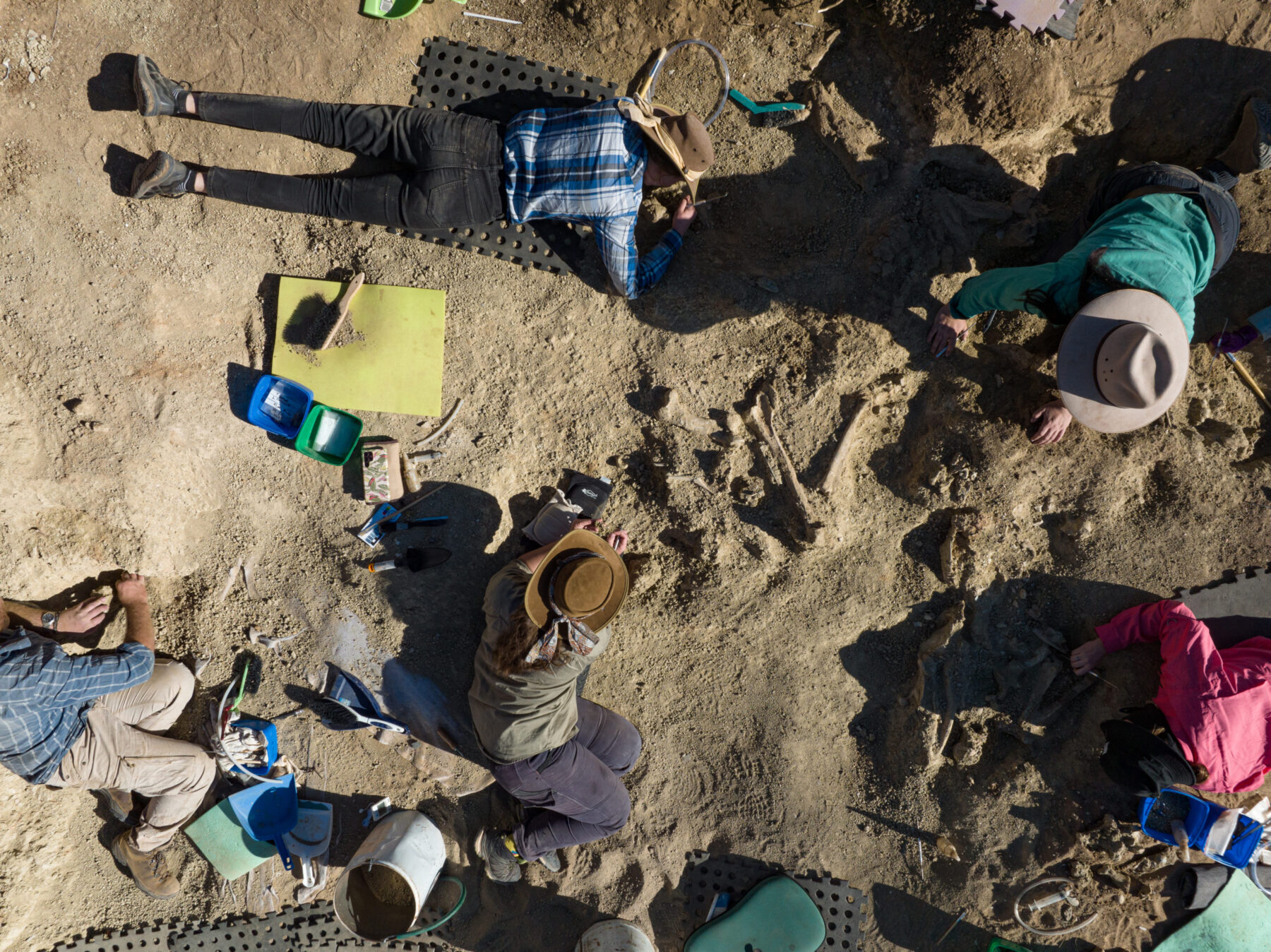
It’s an exciting time to be part of Australia’s palaeontological scene. “We’re at the beginning of the heyday of dinosaurs in Australia,” says Corey Richards, General Manager of Operations at ENHM. “Everything we’re finding, and everything that anyone’s finding [in Australia] is probably going to be a new species.”
Corey says that more dinosaur sites are often found during a fossil dig, as people wander about while taking breaks. “You’re always looking at the ground,” he says. “Everyone’s always looking at the ground, so we might find something.”
Corey quickly proves his point. About an hour later, he says he’s found another scatter of dinosaur bones, a few hundred metres away from the dig site. Melville wants to look at the bone scatter, but they’re unable to find it. They spend half an hour searching the vast, flat landscape – and find a third scatter of dinosaur bones in the process.
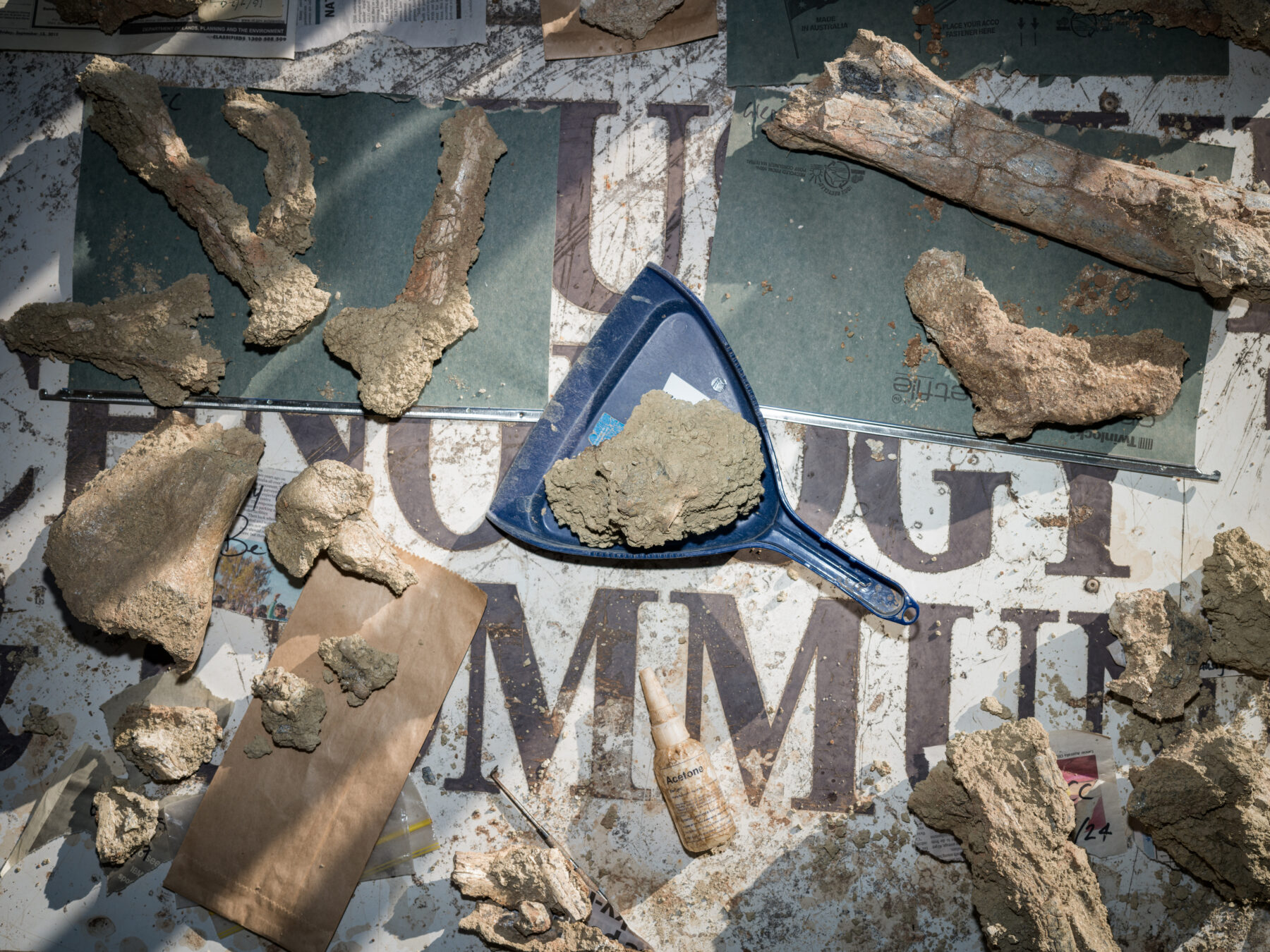
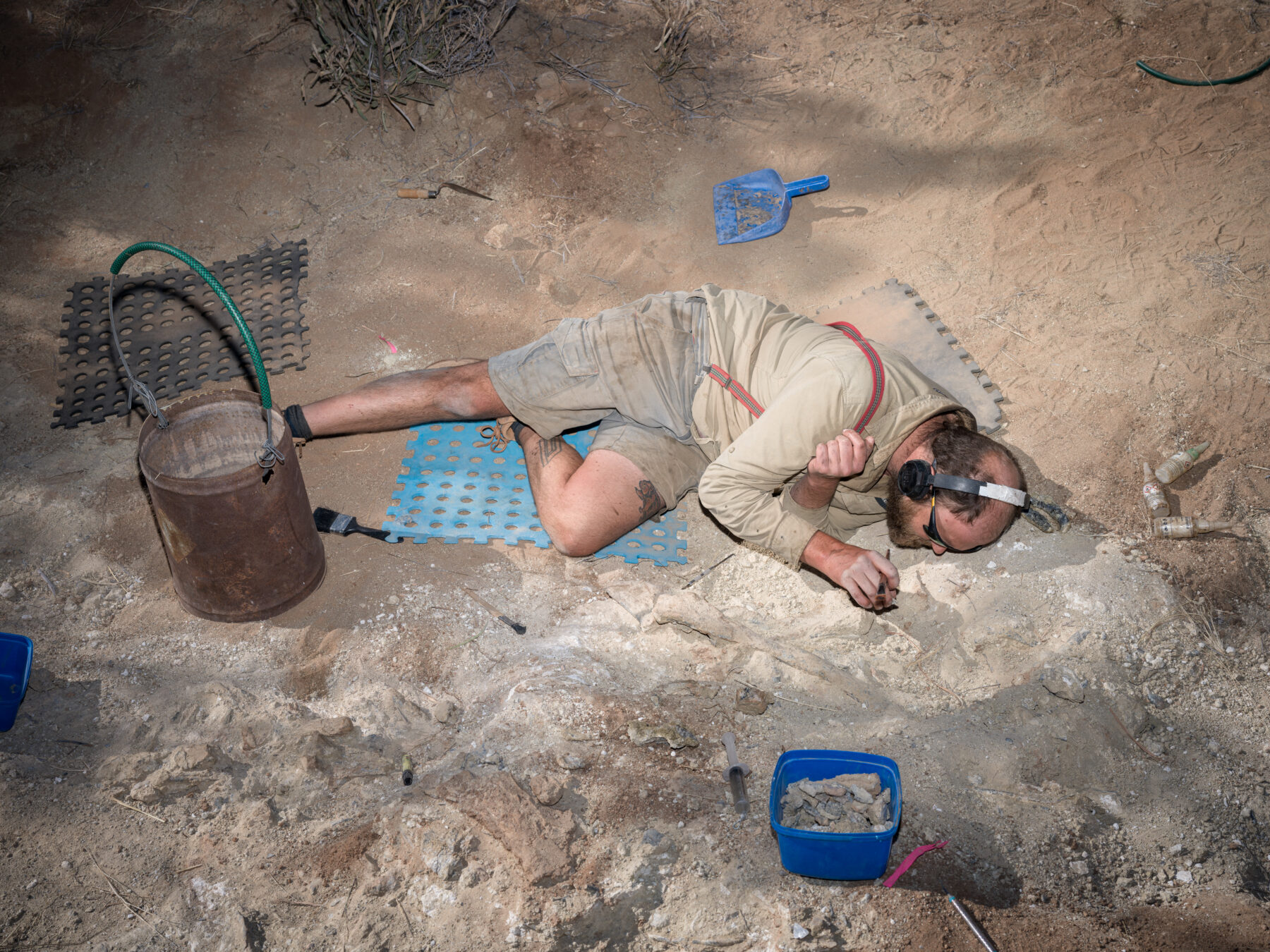
Massive source of fossils
The bones excavated at this year’s dig will soon be jacketed and transported to ENHM’s workshop at Eromanga. But it’ll likely be a few more years until this dinosaur’s story comes to light. “At the moment we have in excess of probably 90 years of prep in the lab,” Corey says, explaining that a single jacket – a protective plaster wrapping for safely transporting fossils – can take a full-time fossil technician at least two years to complete. ENHM’s collection also includes megafauna fossils, excavated each August at their annual dig at Eulo, about 330km south-east of Eromanga by car. “Every year we dig and bring in about another five to 10 years’ worth of material to work on. And that’s where the volunteers become so instrumental in our whole process; they’re the incredible labour that we can’t afford,” Corey says. “But they love it, they get something out of it, and we’re enriched, and it brings a whole culture of people together.”
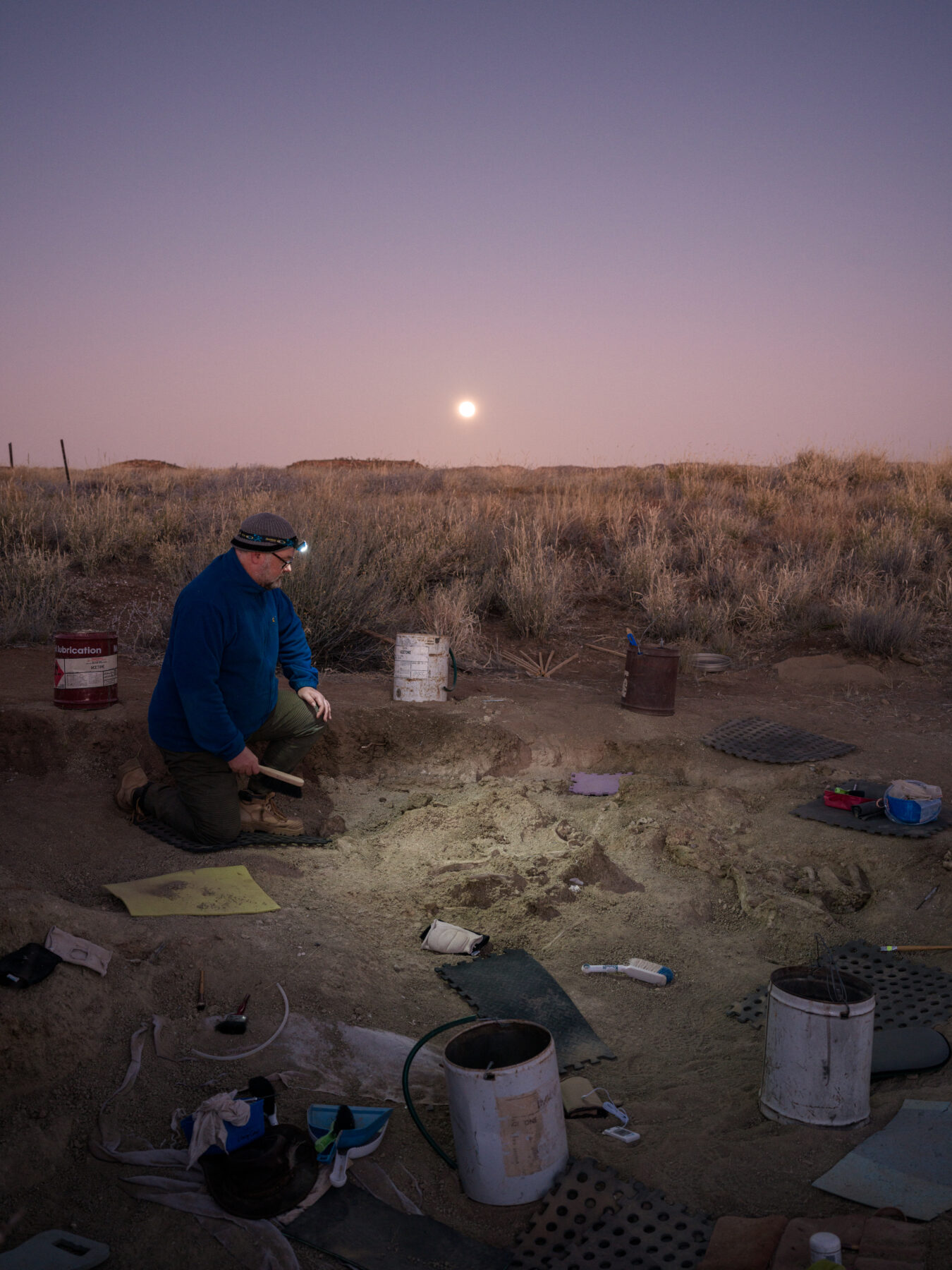
Stepping into ENHM’s workshop feels like venturing into a beehive; there’s a continual buzz of pneumatic tools, ranging from the high-pitched whine of dentist drills to the teeth-rattling rumble of a mini jackhammer. About 11 dinosaurs are currently being prepared in the workshop. It’s a labour of love that requires boundless patience and then some. But volunteers find the work meditative and richly satisfying.
Colin Strickland is a volunteer who travels from Townsville and stays at Eromanga for up six months at a time to prep dinosaur bones. “I just love it,” he says. “Bringing these bones out of the rock, the feeling you get at the end, it’s really beautiful.”
Colin is working on a yet-to-be-described dinosaur called “Monty” that was excavated in 2018. Monty’s fragmented bones are covered in hardened mudstone that has to be scraped away before the fragments can be glued back together. For this reason, Monty has a reputation among ENHM staff and volunteers as a notoriously tricky dinosaur.
“Monty is like a big, unknown jigsaw puzzle,” says Jo Pegler, lab manager at ENHM. “We prep out a piece of rock to expose the bone and then go, ‘Okay, what does this connect to?’ He’s a really interesting specimen. We haven’t prepped an awful lot of him yet, but what we have prepped we know he’s going to be bigger than Cooper.”
This realisation that Monty might be bigger than Cooper – the world’s third-largest dinosaur – has promoted Monty to top priority. It seems that most of today’s volunteers are working on his bones, including husband-and-wife duo Rosslyn and Ben Aspinall. Rosslyn is standing over a table strewn with fragments of Monty’s bones, attempting to find pieces that fit together. “Seeing dinosaur bones in museums doesn’t really do that much for me,” she admits. “But coming out here and seeing the environment where they were once alive, and then being able to actually handle the bones, you’re constantly thinking about them as living beings. It’s quite special, really. It’s why we keep coming back.”
Monty might one day be crowned Australia’s largest dinosaur, but ENHM’s smallest dinosaur is equally interesting. At 12m long, “Sid” the sauropod is considered the baby of the collection, although it’s not yet known if he was a juvenile or an adult of an undescribed species. What is clear, however, is how he died. Sid was trampled to death in a dinosaur trackway – a dinoturbation. Remarkably, his crushed femur bears the perfect imprint of a dinosaur footprint, making Eromanga one of two places in the world – the other being Mongolia – where dinosaur footprints and dinosaur bones have been excavated from the same period.
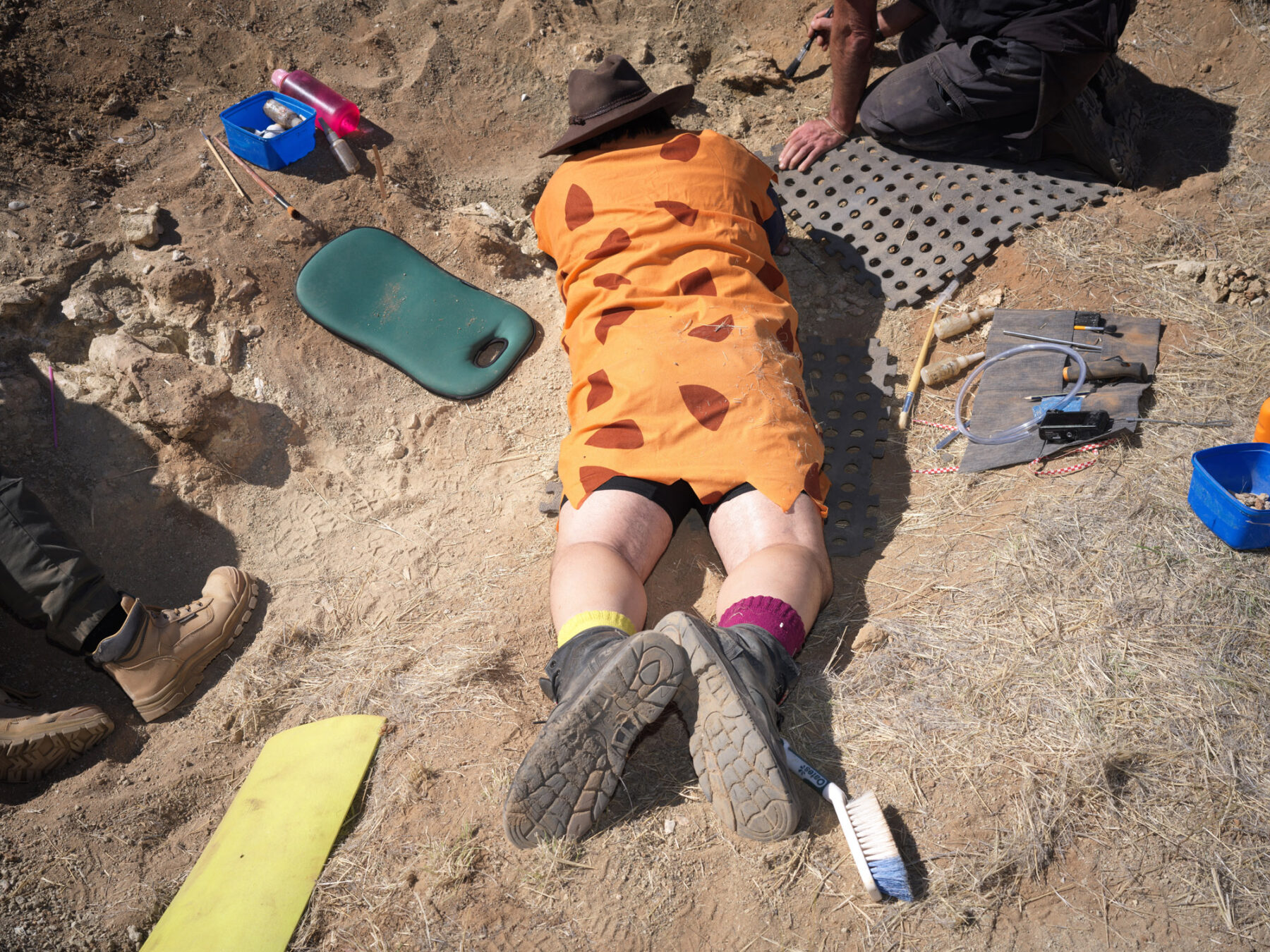
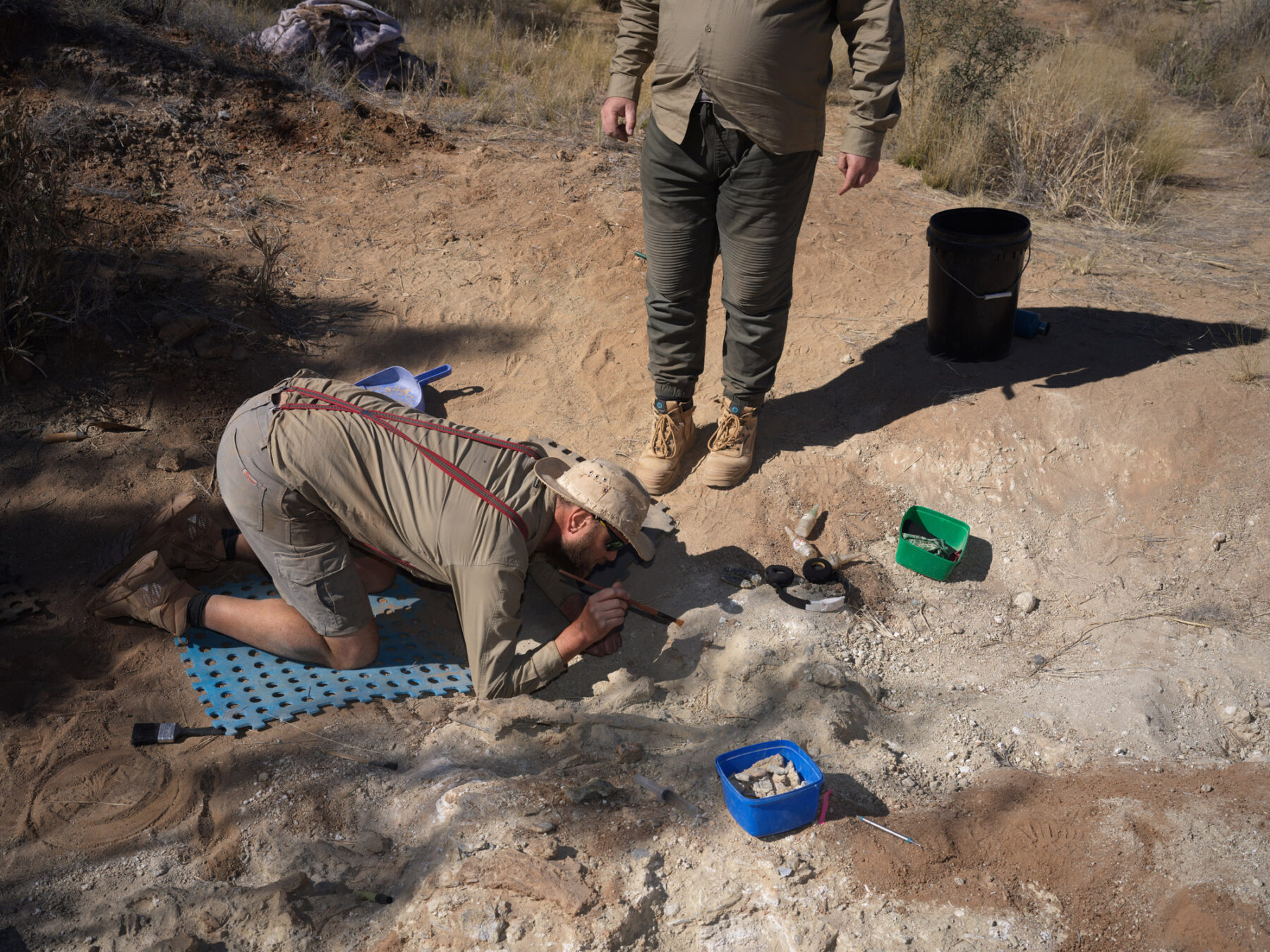
ENHM is also home to “Zac”, Australia’s most complete sauropod. More than 70 of Zac’s bones were excavated in June 2010 – about a third of his skeleton – including a near-complete row of tailbones stretching up to his backside. “What’s cool about Zac is he’s articulated, meaning all the fossils were found in a consecutive manner, as they would be in real life,” Corey says. “They find a lot of articulated fossils in the USA, but in Australia it’s quite rare.”
Not all ENHM volunteers are prepping dinosaurs. Some are working on jackets crammed with megafauna bones, which were preserved in an extinct mud spring about 100,000 years ago during the Pleistocene. These bones are soft and fragile; black speckling across their white surface signifies the beginning of the fossilisation process. Diprotodon is the dominant species found here, but equally fascinating are the microfossils preserved in the surrounding sediment, which offer a window into past environments. John Sheahan sits at a table squinting through a microscope, using tweezers to carefully sift through a Petri dish of sediment. Beside him lies a small box of capsules filled with ancient fish spines and tiny amphibian bones. “It’s just a matter of sorting very carefully under the microscope and spotting fossils,” he says. “It’s like a fossil dig on a microscale.”
Megafauna in the Territory
No dinosaurs have yet been found in the Northern Territory, but Australia’s Red Centre has its own palaeontological treasure trove – Alcoota Scientific Reserve, about 170km north-east of Alice Springs by car. It’s widely regarded as Australia’s richest terrestrial vertebrate fossil site from the late Miocene. Concentrated inside these fossil beds are tens of thousands of bones, from thousands of animals that died about 8mya.
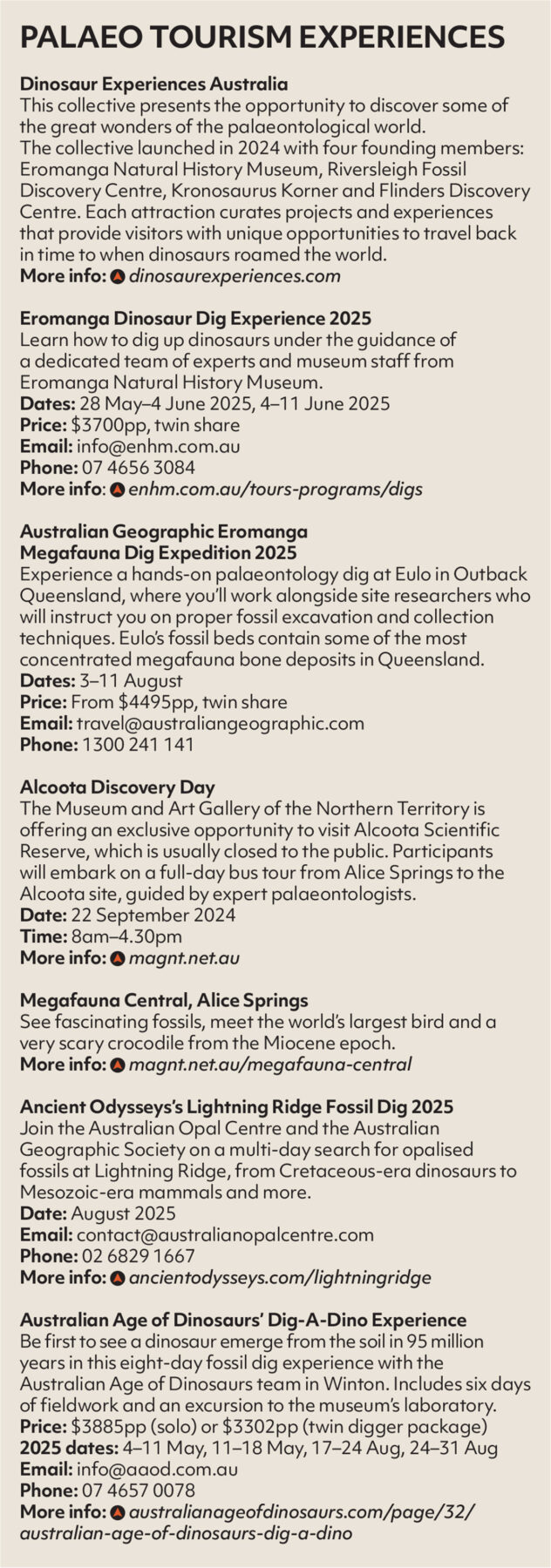
Every two years, the Museum and Art Gallery of the Northern Territory (MAGNT) holds a three-week dig at Alcoota. People from across the country – palaeontologists and museum staff from MAGNT and Megafauna Central in Alice Springs, paying volunteers and academics from Flinders University Palaeontology Society – venture to this isolated pocket of the outback to piece together a chapter of Australia’s past. Some volunteers arrive with no palaeontology experience, but within a few days are digging confidently in the pits, working side by side with experts. There’s a strong sense of camaraderie each night at this year’s dig as people chat and crack jokes around the campfire, before retreating to tents just a stone’s throw from the fossil beds. More than 30 mammal, bird and reptile species are represented at Alcoota, including marsupial “rhinos” (Diprotodontiae), short-faced kangaroos, crocodilians, giant flightless birds (Dromornithidae) and fearsome marsupial lions the size of a leopard. These animals are the evolutionary ancestors of the Pleistocene megafauna that lived alongside the First Australians.
Today, their bones lie scattered at the bottom of a fault-bounded basin, disarticulated in a random jumble. “It seems no matter how much we dig, there’s more to come,” says Dr Adam Yates, Senior Curator of Earth Sciences at MAGNT. Adam is standing in Classy Corner, a new pit opened two weeks ago at the start of the dig. He points to a scatter of vertebrae beside a long, slender femur, a drumstick half-submerged in silt, and shoulder blades sitting flush against the branches of a lower jawbone with a preserved row of teeth. “This is the thing about Alcoota: Once you start excavating one thing and clearing around it, you find more. It’s like a game of pick-up sticks in some ways,” Adam says.
The first kangaroos
Excavating this ancient graveyard tells a story of animals living through climate change – the drying out of Australia during the late Miocene. “The climate had been drying out in fits and starts with little reversals here and there for quite some time, but this is when Australia really began drying out in earnest,” Adam explains. As the landscape dried out, water sources became scarce and forests retreated, eventually replaced by open lower woodlands, shrublands and grasslands. “The rivers probably changed from meandering streams that may have had water in them permanently, to rivers that are more like the rivers we have here now – dry most of the year and then discharging with a big flash-flood style,” Adam says. “These animals are wrapped up in that story; they’re part of it as it’s happening. And it’s a unique window because hardly any other sites in Australia – none as rich as here – record that crucial bit of time in the late Miocene when things were drying out.”
How these animals died is a mystery. Palaeontologists once thought these fossils were the remains of animals that gathered around a surviving waterhole during a years-long drought. But recent evidence that the animals were in breeding condition when they died has cast doubt on that hypothesis. Now Adam speculates they were killed in a flood. “[After drowning], their carcasses drifted downstream and banked up at one spot, maybe a bend in the river or something like that. And that’s what we’re digging through; it’s just a giant pile of carcasses that piled up after a flood,” he says. “I sort of envisage something like that being a quite likely scenario for the accumulation of all these bones at Alcoota, but we need to test it. We need to get more evidence to either support that or possibly falsify it, and then we have to move on to yet another hypothesis. We’ve falsified the drought hypothesis, so yeah, we’re getting there.” The pit’s concentrated assortment of bones seem to support the flood hypothesis. But Adam is bothered by the handful of Baru crocodiles in the deposit. “Crocodiles don’t die in floods,” he says.
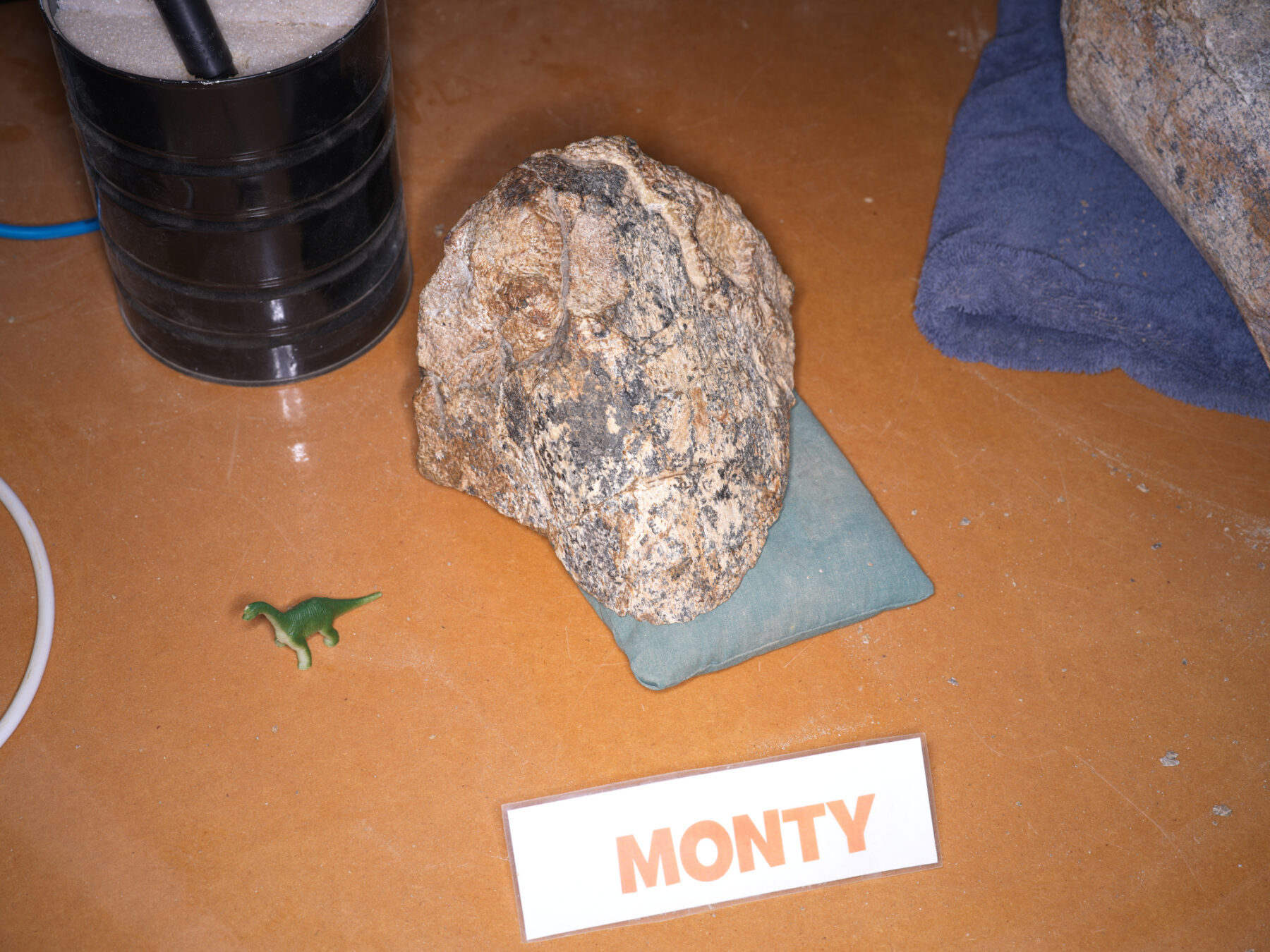
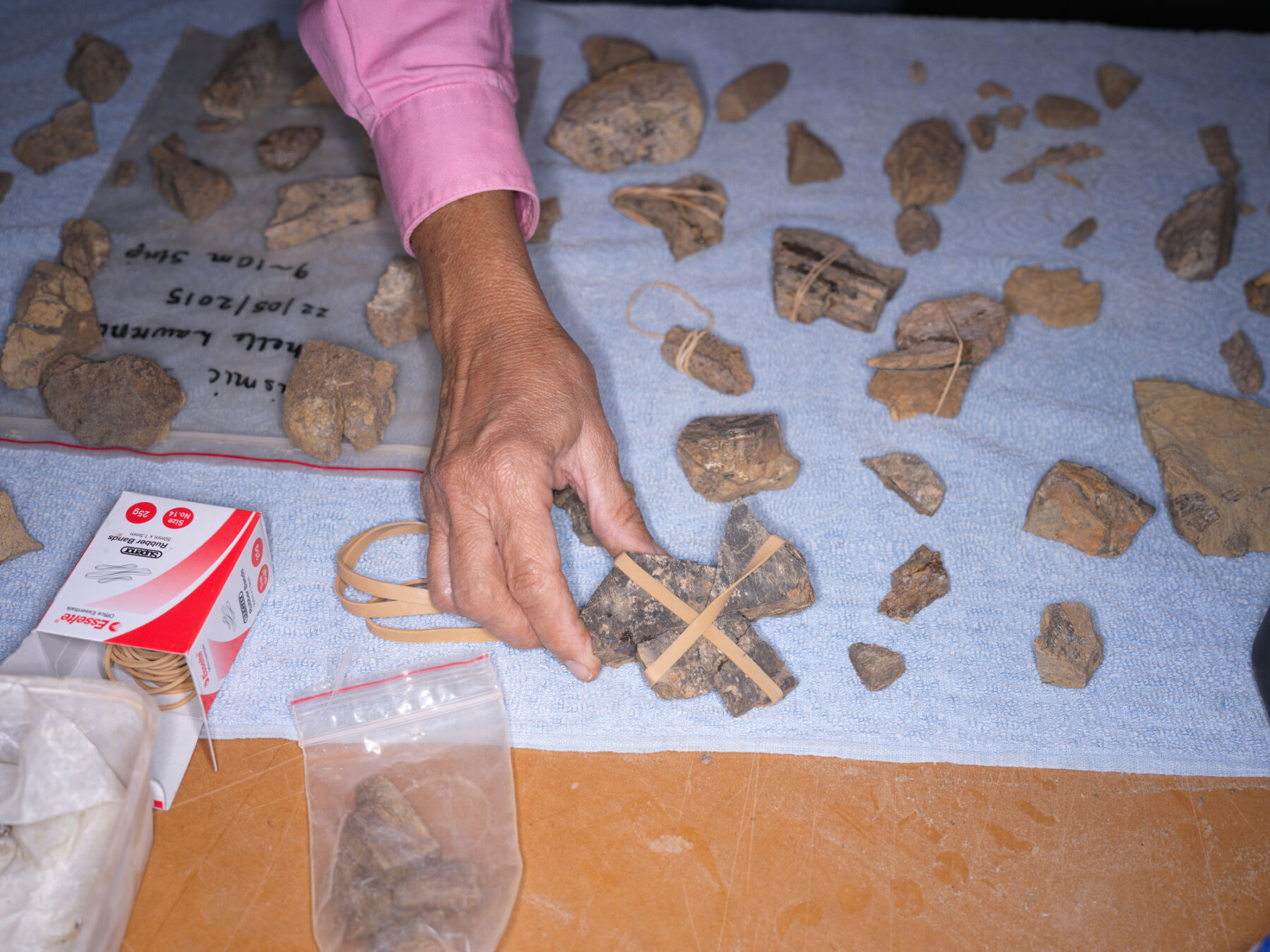
Whatever caused the death of these animals represents just one part of their story. Palaeontologists are equally interested in the unique adaptations they developed in response to the drying landscape, as animals travelled further distances to find food and water sources. For example, the kangaroos preserved at Alcoota have longer tibias (lower leg bones) and different ankle joint adaptations than their predecessors.
“If you could re-create all of the species in the ancient kangaroo lineages, Alcoota is where they start to really look like kangaroos,” says Dr Samuel (Sam) Arman, MAGNT Technician in Earth Sciences, explaining that before the Miocene their limb proportions gave them a more “possum-like” appearance. “[Before the Miocene] they’d be doing a lot of bounding, moving their hindlimbs and their forelimbs together, which is what a lot of animals do today.”

At least three kangaroo species have been excavated at Alcoota, including two sthenurine, or short-faced, kangaroo species. There’s also Dorcopsoides, a forest wallaby, the ankle bones of which are among the most commonly found fossils inside the pits. All three species specialised in hopping, not bounding, making Alcoota’s fossil deposits an important site in tracing kangaroos’ evolutionary lineage.
“Hopping is a super-efficient way to get across a landscape, because once you’re hopping, increases in speed don’t cost you very much in energy – you’re using the kinetic energy of your movement to create more movement,” Sam says. “It’s not like treading, where we have to put our muscles into action every time. Once you’re hopping, you’re just cruising. It’s actually kind of bizarre that it hasn’t happened more times in evolution.”
Sam is digging in Main Pit, one of the oldest pits at Alcoota. This pit, which produced the bulk of material on display at Megafauna Central in Alice Springs, has been excavated down to the bottom of the bone bed and most of its remaining fossils are smashed and broken. Further complicating matters is the calcrete that cements the bones together and makes the ground tough to dig through.
At the opposite end of Alcoota is South Pit, where the high bone density resembles a logjam. Three volunteers are digging in this pit. They use paintbrushes to carefully brush away the silt, occasionally blowing though a plastic straw to gently puff away sediment. Unlike Eromanga’s dinosaur bones, the fossils at Alcoota haven’t yet lithified – turned into rock. Some are so fragile that brushing with too much pressure causes surfaces to crumble into tiny pieces that look like desiccated coconut. The volunteers are forever laying aside paintbrushes and probes and reaching for a squirty bottle of paraloid – a reversible adhesive – which they dribble generously onto the fossil and its surrounding sediment. The paraloid helps consolidate the bone, soaking through its cracks and microscopic fissures to help bind the fossil and strengthen it.
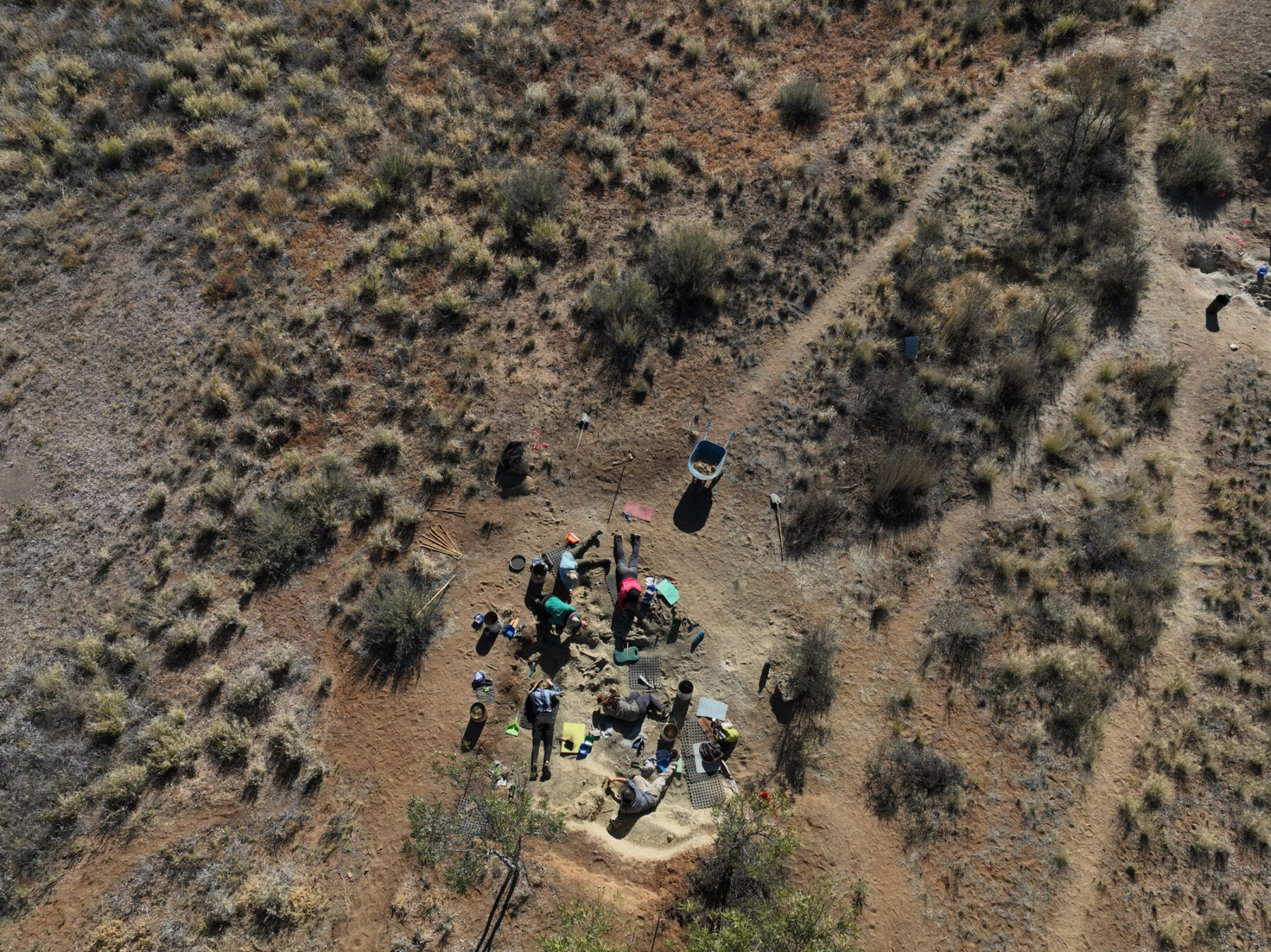
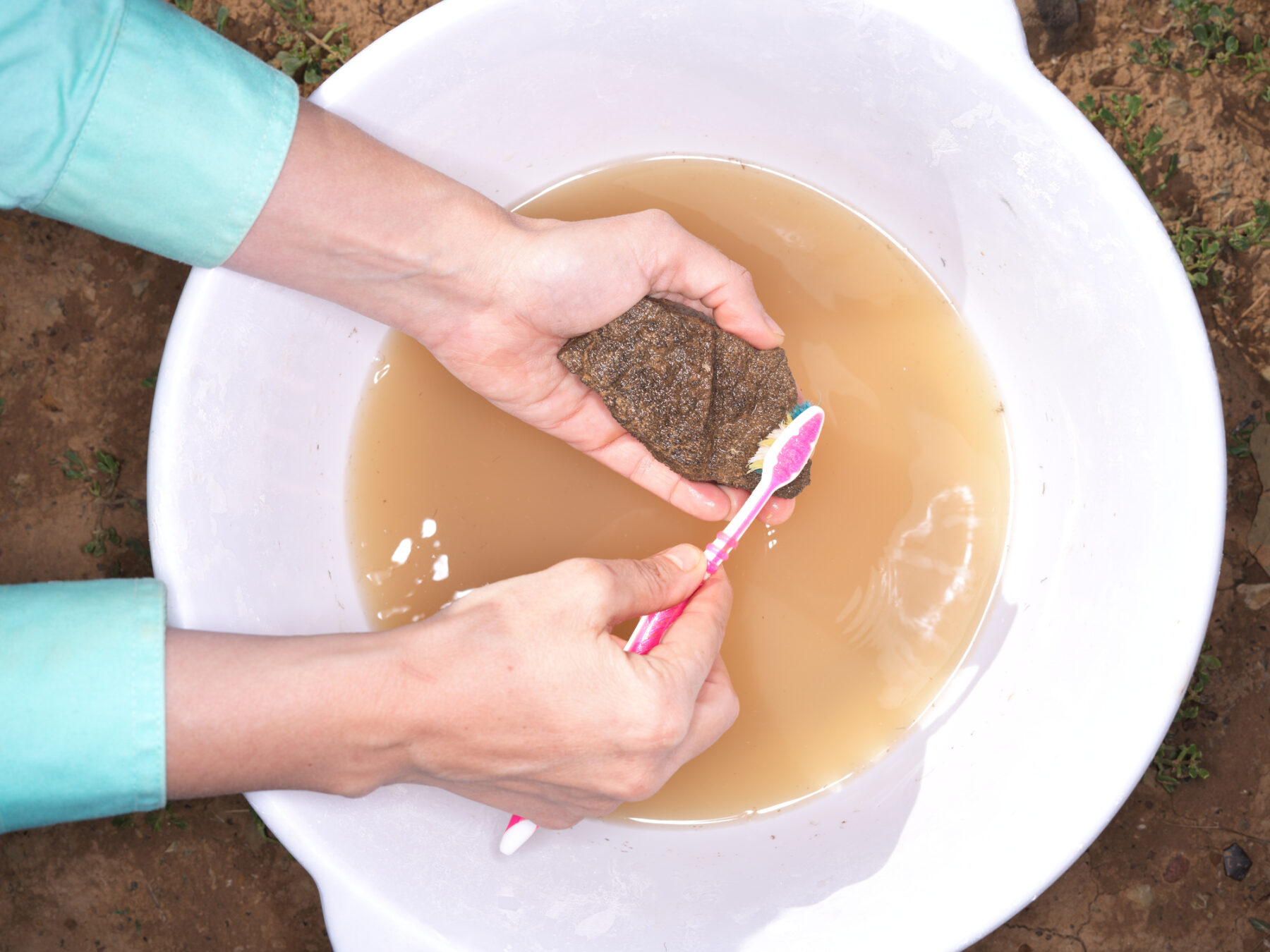
One of the volunteers is Louise Kean, a senior ranger at NT Parks and Wildlife in Darwin. Louise first visited Alcoota in 1989 as a Flinders University student. She describes it as a formative experience that made her fall in love with the NT and helped pave the path of her career. “I have such a strong connection to this place,” she says. “It’s like a piece of music, or a poem, that gives people that special feeling you can’t articulate. For me, Alcoota is that piece.” Louise volunteers at Alcoota every chance she gets. Her past visits to Alcoota mean she’s deeply knowledgeable about the site. She’s able to help other volunteers, answering their questions and identifying bones from rocks and calcite. Digging inside a pit for hours can be physically demanding, but Louise is animated by the work, which she describes as the perfect blend of her passions for ecology, biology and conservation. “It’s nice to be putting together pieces of the past,” she says. “It’s like a book with missing pages.”
Joining Louise in South Pit are Steve Parker and Paul Evans, two mates from Victoria. “It’s something I’ve always, since I was a child, dreamt of doing,” Steve says. “It’s a real privilege to work with experts in the field.”
Steve has spent the past few days digging out a Kolopsis pelvis. The Kolopsis torus was a sheep-sized marsupial herbivore that was an early member of the Diprotodontidae family, the distant ancestors of modern wombats, and one of the dominant groups found at Alcoota. The pelvis is almost ready to be taken out of the ground, but Steve wants to squirt a few more bottles of paraloid onto a bone before attempting to flip it, so the bone doesn’t crumble. Lifting the bone, especially a large one, from the fossil bed is always a risk; most are shot through with fractures, cracked after millennia of being buried inside clay expanding and contracting with wet and dry weather. The more paraloid a bone receives, the better. Steve has helped prepare dinosaur fossils in Winton in Queensland but appreciates the fossils here at Alcoota – ancient animals living through a period of climate change – for having modern relevance. “We’ve got to look to the past to manage the future,” he says.
Another new discovery
In the middle of Classy Corner is a find that’s generating the most excitement – the articulated femur, ankle and nine toe bones of an Ilbandornis, an ostrich-sized flightless bird from the Dromornithid family (also known as thunder birds or demon ducks). Finding an articulation like this – the bones lying in the same position as when the animal died – is rare at Alcoota, where the bones are usually jumbled.
Several people lie at awkward angles in the pit, careful to not rest a hand or foot on the bones protruding haphazardly from the ground. Among them is Dr Phoebe McInerney, a palaeontology researcher from Flinders University who specialises in Dromornithids. This family of huge flightless birds first appeared in the fossil record about 55mya, until their extinction about 50,000 years ago. Dromornithidae are believed to have been flightless for at least 45 million years, and by the late Miocene some thunder bird species had a chicken-sized humerus (wing bone). It’s so small that it might’ve been a vestigial structure that didn’t protrude through the skin.
Phoebe says this lost flight ability likely emerged after dinosaurs became extinct. “There are many benefits to flight, which is why it evolved in the first place,” she says. But flight is so energy consuming that if a bird doesn’t need to fly it will lose the ability to do so. “Without [dinosaur] predation, Dromornithidae would have been able to [become] giant and flightless and there just wasn’t any need for them to fly or even be able to run away. Once Dromornithidae got really big, not much would be able to take one down.”
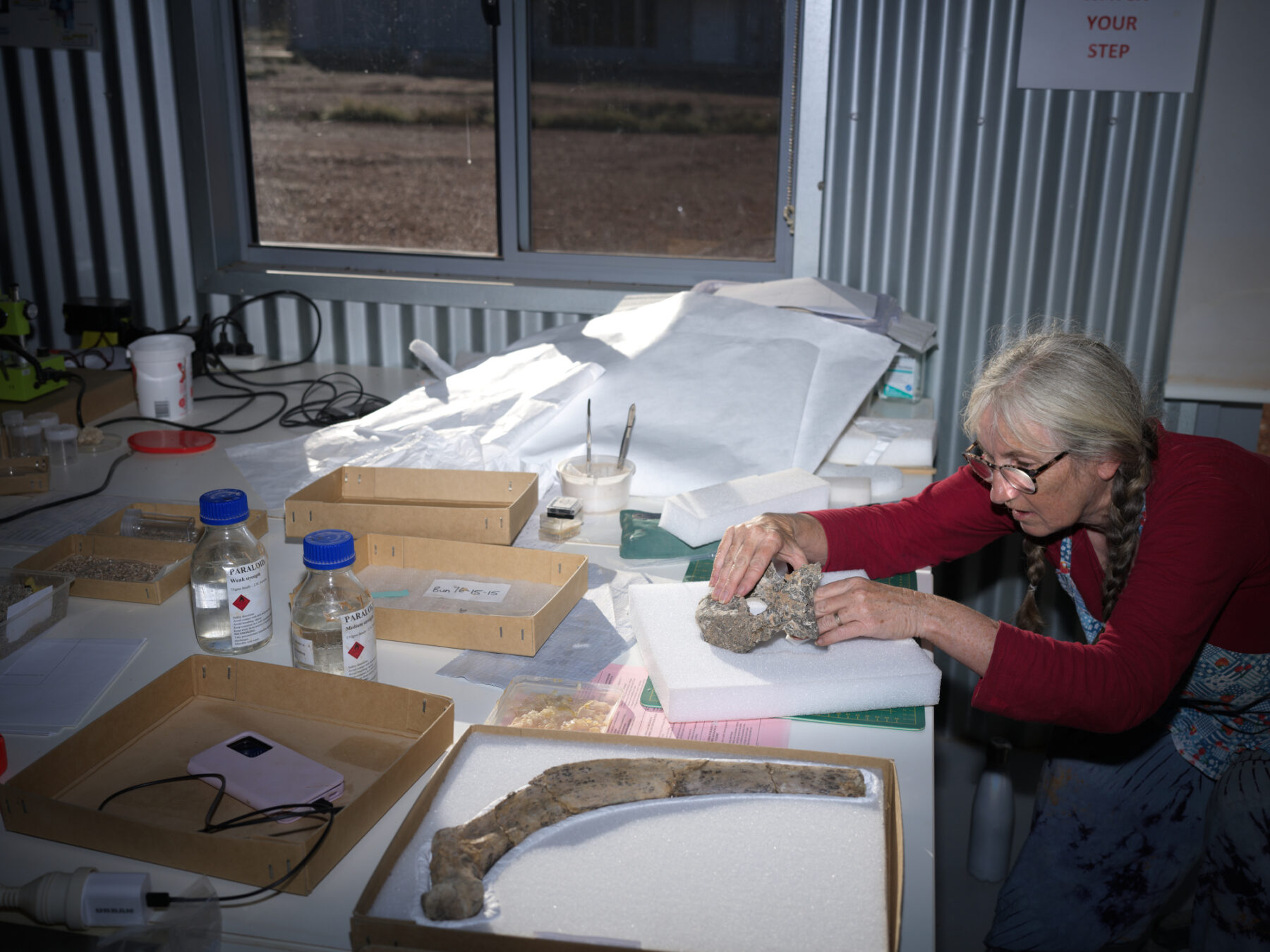

Three Dromornithidae species are found at Alcoota. One is the Dromornis stirtoni, which weighed an estimated 600kg and stood 2–3m tall, the largest bird species to ever roam Earth. Dromornithidae were thought to be the evolutionary ancestors of modern-day flightless ratites – emus, cassowaries, ostriches and rheas – but recent research suggests their closest descendants are waterfowl, including ducks and geese. Phoebe says these giant birds have no living relatives in Australia, their closest relatives being South American screamers.
Adam helps excavate the Dromornithid leg, ankle and toe bones in Classy Corner. He points to a shoulder joint and vertebra lying near the articulation, all of which belong to the same species. “There could be a skeleton that belongs to one individual,” he says. “That’s really significant because there’s more than one [Ilbandornis] species and associating particular bone types with each particular species can be quite tricky.” Adam explains the two Ilbandornis species – woodburnei and lawsoni – are distinguished by the shape of their footbone; lawsoni’s bones were long and thin, probably adapted for fast running, whereas woodburnei was shorter and bulkier. There’s still speculation about which bones belong to which species. “There’s every potential as we dig that we’re going to find some more skeletons,” Adam says. And that will provide a more complete picture of what we’re learning from Alcoota than just a pile of old bones.
Australian Geographic would like to thank NT Tourism and Dinosaur Experiences Australia for their assistance with this article.



